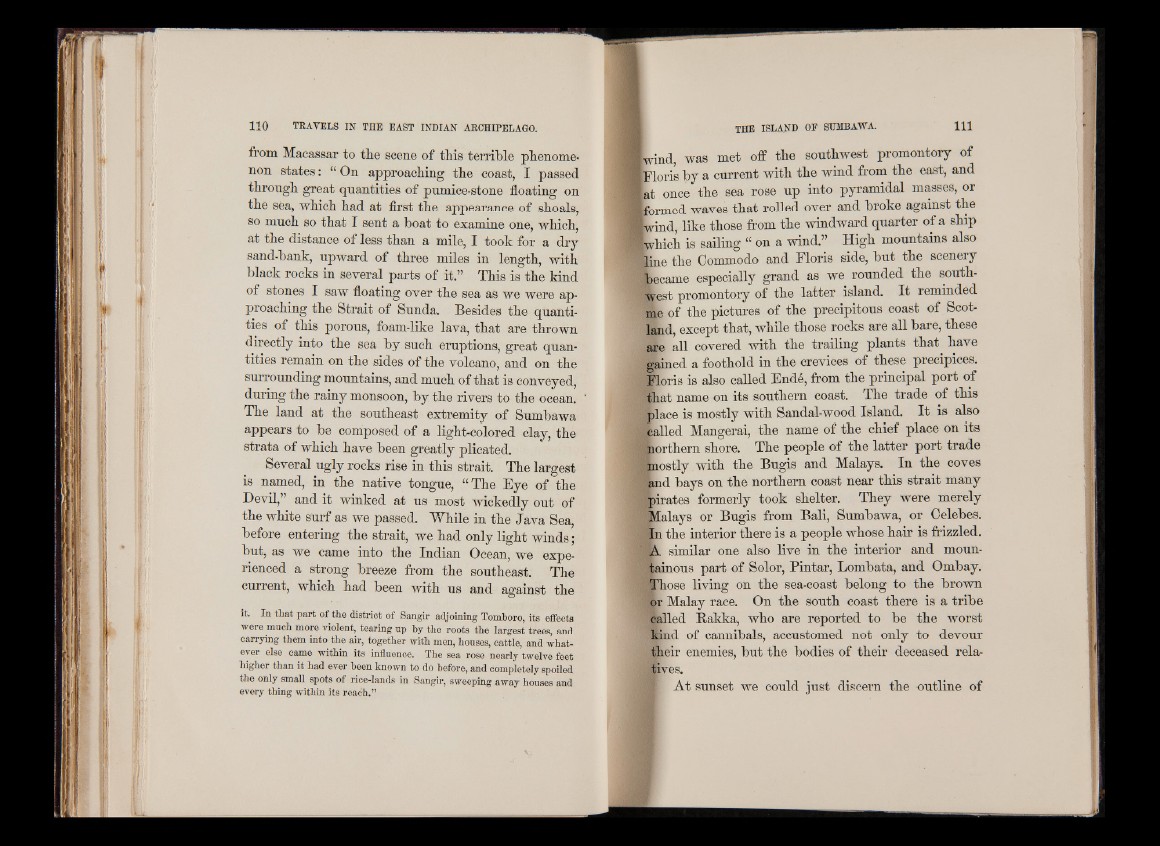
from Macassar to the scene of this terrible phenomenon
states: “ On approaching the coast, I passed
through great quantities of pumice-stone floating on
the sea, which had at first the appearance of shoals,
so much so that I sent a boat to examine one, which,
at the distance of less than a mile, I took for a dry
sand-bank, upward of three miles in length, with
black rocks in several parts of it.” This is the kind
of stones I saw floating over the sea as we were approaching
the Strait of Sunda. Besides the quantities
of this porous, foam-like lava, that are thrown
directly into the sea by such eruptions, great quantities
remain on the sides of the volcano, and on the
surrounding mountains, and much of that is conveyed,
during the rainy monsoon, by the rivers to the ocean.
The land at the southeast extremity of Sumbawa
appears to be composed of a light-colored clay, the
strata of which have been greatly plicated.
Several ugly rocks rise in this strait. The largest
is named, in the native tongue, “ The Eye of the
Devil,” and it winked at us most wickedly out of
the white surf as we passed. While in the Java Sea,
before entering the strait, we had only light winds j
but, as we came into the Indian Ocean, we experienced
a strong breeze from the southeast. The
current, which had been with us and against the
it. In that part of the district of Sangir adjoining Tomhoro, its effects
were much more violent, tearing up by the roots the largest trees, and
carrying them into the air, together with men, houses, cattle, and whatever
else came within its influence. The sea rose nearly twelve feet
higher than it had ever been known to do before, and completely spoiled
the only small spots of rice-lands in Sangir, sweeping away houses and
every thing within its reach.”
t i n d , was met off the southwest promontory of
■Floris by a current with the wind from the east, and
| a t once the sea rose up into pyramidal masses, or
■formed waves that rolled over and broke against the
■wind, like those from the windward quarter of a ship
■which is sailing “ on a wind.” High mountains also
||i n e the Commodo and Floris side, but the scenery
became especially grand as we rounded the southwest
promontory of the latter island. It reminded
me of the pictures of the precipitous coast of Scotland,
except that, while those rocks are all bare, these
are all covered with the trailing plants that have
gained a foothold in the crevices of these precipices.
Floris is also called End6, from the principal port of
that name on its southern coast. The trade of this
place is mostly with Sandal-wood Island. It is also
R a iled Mangerai, the name of the chief place on its
northern shore. The people of the latter port trade
mostly with the Bugis and Malays. In the coves
and bays on the northern coast near this strait many
pirates formerly took shelter. They were merely
IgMalays or Bugis from Bali, Sumbawa, or Celebes.
In the interior there is a people whose hair is frizzled.
* lA. similar one also live in the interior and mountainous
part of Solor, Pintar, Lombata, and Ombay.
Those living on the sea-coast belong to the brown
or Malay race. On the south coast there is a tribe
called Rakka, who are reported to be the worst
kind of cannibals, accustomed not only to devour
their enemies, but the bodies of their deceased relatives.
At sunset we could just discern the outline of